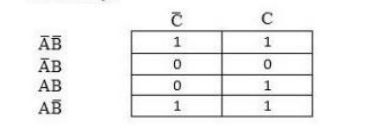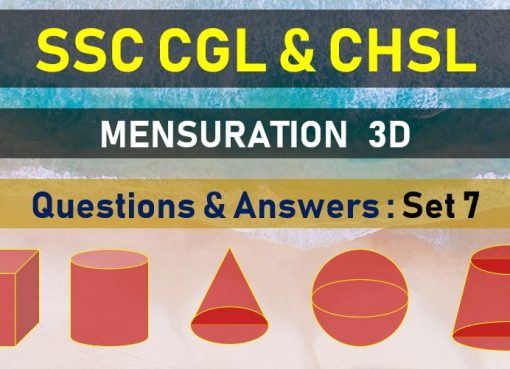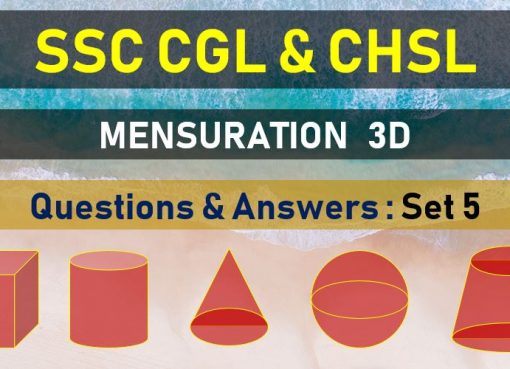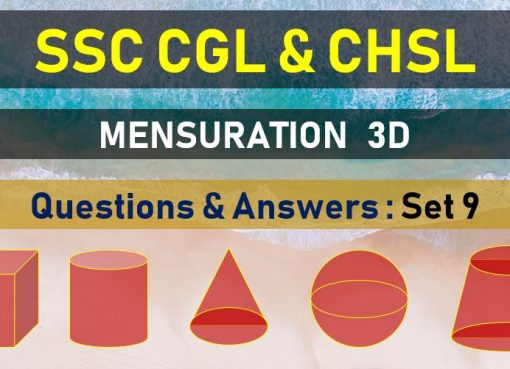Hi students, Welcome to Amans Maths Blogs (AMBIPi). Are you preparing for SSC Scientific Assistant and looking for SSC Scientific Assistant Electronics Questions 141 to 160 with Answer Keys? In this article, you will get previous year questions of SSC Scientific Assistant IMD (Indian Meteorological Department), which helps you in the preparation of government job of SSC IMD Scientific assistant.
SSC Scientific Assistant IMD Previous Year Questions
SSC Scientific Assistant Electronics Question No: 141
What is the simplest expression for the k-map shown in the figure given below ?

Option A : X = B + AC
Option B : X = ABC + ABC
Option C : X = AB + AB
Option D : X = AB
Show/Hide Answer Key
Option
SSC Scientific Assistant Electronics Question No: 142
What is the output for the network given below ?
Option A :X = ((A+B)C)D
Option B : X = ((A+B)(C+D)
Option C : X = A+(B+(CD))
Option D : X = ((AB)+C)+D
Show/Hide Answer Key
Option D : X = ((AB)+C)+D
SSC Scientific Assistant Electronics Question No: 143
The group of bits 01010 is a serially shifted (right-most bit first) into a 5-bit parallel output shift register with an initial state of 01111. What is the value contained in the register after 2 clock pulses ?
Option A : 01010
Option B : 01011
Option C : 01001
Option D : 10011
Show/Hide Answer Key
Option D : 10011
SSC Scientific Assistant Electronics Question No: 144
What is the number of flip-flops required to produce a divide by-64 device ?
Option A : 4
Option B : 5
Option C : 6
Option D : 7
Show/Hide Answer Key
Option C : 6
SSC Scientific Assistant Electronics Question Paper No: 145
What is the Dew Morgan’s equivalent to the expression ABCD ?
Option A : ABCD
Option B : A + B + C +D
Option C : A + B + C + D
Option D : A + (B + (CD))
Show/Hide Answer Key
Option
SSC Scientific Assistant Electronics Question No: 146
What is the nature of waves generated by the transmitting antenna in a radio communication ?
Option A : Plane
Option B : Rectangular
Option C : Square
Option D : Spherical
Show/Hide Answer Key
Option D: Spherical
SSC Scientific Assistant Electronics Question No: 147
What is the change in direction (dB) of a half wave dipole antenna ?
Option A : 1.76
Option B : 2.15
Option C : 6.25
Option D : 13.46
Show/Hide Answer Key
Option B : 2.15
SSC Scientific Assistant Electronics Paper No: 148
What is NOT an property of an end fire array?
Option A : It uses two half waves dipoles at distance of one half wavelength
Option B : Provide narrower beam width than broad side array
Option C : The gain is less than that of array
Option D : It is a stacked collinear antenna
Show/Hide Answer Key
Option D : It is a stacked collinear antenna
SSC Scientific Assistant Electronics Paper No: 149
What is NOT an application of a parabolic antenna ?
Option A : Direct television broadcast
Option B : Used as cellular microwave link
Option C : Wi- Fi – link
Option D : Satellite communication
Show/Hide Answer Key
Option C : Wi – Fi link
Previous Year Question SSC Scientific Assistant Electronics: 150
Which among the following components are used n the Yagi antenna ?
Option A : Dipole, one reflector and many directors
Option B : One reflector and one director
Option C : One director
Option D : Two reflectors
Show/Hide Answer Key
Option A : Dipole, one reflector and many directors
SSC Scientific Assistant Electronics Question No: 151
Which of the following factors affects the propagation level of an EM wave travelling from a transmitter to a receiver ?
A. Curvature of earth
B. Roughness of earth
C. Magnetic field of earth
Option A : 1
Option B : 2
Option C : 3
Option D : 1, 2 and 3
Show/Hide Answer Key
Option D : 1, 2 and 3
SSC Scientific Assistant Electronics Question No: 152
Choose which propagation of medium can handle VHF and UHF.
1. Ground wave propagation
2. Sky wave propagation
3. Space wave propagation
Option A : 1 only
Option B : 2 only
Option C : 3 only
Option D : Both 1 and 2
Show/Hide Answer Key
Option C : 3 only
SSC Scientific Assistant Electronics Previous Year Question No: 153
Select the correct order of the following atmospheric zones on the basis of the numbers of free electrons residing in them
Option A : Troposphere > Stratosphere > Ionosphere
Option B : Ionosphere > Stratosphere > Troposphere
Option C : Stratosphere > Troposphere > Ionosphere
Option D : Stratosphere > Ionosphere > Troposphere
Show/Hide Answer Key
Option B : Ionosphere > Stratosphere > Troposphere
SSC Scientific Assistant Electronics Question No: 154
What is the frequency range of low frequency ?
Option A : 30 – 300 Hz
Option B : 300 – 3000 Hz
Option C : 3 – 30 kHz
Option D : 30 – 300 kHz
Show/Hide Answer Key
Option D : 30 – 300 kHz
SSC Scientific Assistant Electronics Paper No: 155
Which properties can be varied in a modulation for the addition of information to a carrier signal ?
1. Amplitude
2. Frequency
3. Phase
4. Polarization
Option A : 1 and 2 only
Option B : 2 only
Option C : 1 , 2 and 3 only
Option D : 1, 2 , 3 and 4
Show/Hide Answer Key
Option D : 1 , 2 , 3 and 4
SSC Scientific Assistant Electronics Previous Year Paper Question No: 156
Which of the following in NOT a type of analog modulation ?
Option A : PPM
Option B : AM
Option C : FM
Option D : PM
Show/Hide Answer Key
Option A : PPM
SSC Scientific Assistant Electronics Previous Year Paper Question No: 157
What is the total power (in W) of an 80% DSB- SC modulated carrier wave having a power of 120 W ?
Option A : 34.4
Option B : 38.4
Option C : 42.4
Option D : 46.4
Show/Hide Answer Key
Option B : 38.4
SSC Scientific Assistant Electronics Year Question Paper No: 158
An AM wave has the lowest frequency component of 790 Hz with an 90 Hz wide band. What is the carrier frequency of the wave ?
Option A : 700 Hz
Option B : 745 Hz
Option C : 835 Hz
Option D : 935 Hz
Show/Hide Answer Key
Option C : 835 Hz
SSC Scientific Assistant Electronics Question Paper No: 159
The maximum transmission efficiency of an sinusoidal AM signal is ?
Option A : 21.68 %
Option B : 33.33 %
Option C : 58.88 %
Option D : 65.55 %
Show/Hide Answer Key
Option B : 33.33 %
Previous Year Question SSC Scientific Assistant Electronics: 160
In which of the following does radio waves propagates ?
Option A : EM waves
Option B : Fiber optic cables
Option C : Insulators
Option D : Water
Show/Hide Answer Key
Option A : EM Waves
Know About SSC Scientific Assistant: Click Here.
Get SSC Scientific Assistant Previous Year Questions.
| SSC Scientific Assistant Previous Year Questions Bank |
| SSC General Intelligence Previous Year Questions | 1 to 20 | 21 to 40 | 41 to 60 | 61 to 75 |
| SSC General Awareness Previous Year Questions | 1 to 20 | 21 to 40 | 41 to 60 | 61 to 75 |
| SSC Computer Science Previous Year Questions | 1 to 20 | 21 to 40 | 41 to 60 | 61 to 80 | 81 to 100 | 101 to 120 | 121 to 140 | 141 to 160| 161 to 180 | 181 to 200 |
| SSC Quantitative Aptitude Previous Year Questions | 1 to 20 | 21 to 40 | 41 to 60 | 61 to 75 |
| SSC Physics Previous Year Questions | 1 to 20 | 21 to 40 | 41 to 60 | 61 to 80 | 81 to 100 |
| SSC Electronics Previous Year Questions | 1 to 20 | 21 to 40 | 41 to 60 | 61 to 80 | 81 to 100 101 to 120 | 121 to 140 | 141 to 160 | 161 to 180 | 181 to 200 | 201 to 220 | 221 to 240 | 241 to 260 | 261 to 280 | 281 to 295 | |




